Broadcast Participants
Alice Bryant
Bird Curator
Ketchikan Indian Community Deer Mountain Tribal Hatchery and Eagle Center
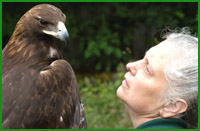
Ms. Bryant, who has B.A. degree in psychology with a minor in biology, has years of experience working with birds. She started working with parrots in 1989 and has since worked and volunteered with a variety of bird rehabilitation and education organizations in New York and Alaska. At Cornell University, she volunteered at its raptor rehabilitation and breeding program. From Cornell, Ms. Bryant went to the Alaska Raptor Rehabilitation Center in Sitka to teach about raptors and help with raptor rehabilitation, working mainly with Bald Eagles. She returned to New York working for six years with an organization in Rochester, NY, starting out as a volunteer taking care of the birds and their enclosures and doing raptor education. In this volunteer organization, she worked her way up to become educator/volunteer coordinator and then executive director where she was responsible for the health of birds, upkeep of the bird enclosures, and glove and flight training.
Alice went to VINS in 2002 as lead raptor educator conducting education programs and training birds and staff, interns, and volunteers in the care and handling of the birds. In February 2004, Alice filled the senior bird trainer position where her full time responsibility was training VINS’ non-releasable raptors and training the human bird handlers. During her time with VINS, Alice presented a talk about training raptors to a National Raptor Rehabilitation Conference in Kentucky.
In September 2005, Ms. Bryant moved to Alaska to become the bird curator at the Ketchikan Indian Community Deer Mountain Tribal Hatchery and Eagle Center.
Victor M. Cuevas
Forest Service, Caribbean National Forest

Mr. Cuevas has worked with the Caribbean National Forest for 21 years in many different capacities. He began working with the Puerto Rican Parrot Recovery Program in 1984 and for over 10 years this was the main thrust of his work. The wildlife team got an opportunity to share their parrot management technologies with other Caribbean countries, and Victor traveled to Trinidad, Saint Lucia, Belize, Venezuela, and other countries. He also created protocols for monitoring tree frogs species and organized expeditions into wilderness areas to sample proposed, endangered, rare, and threatened wildlife and plants species.
In 2001, he became part of the customer services team as the visitor Information Services Operation Leader. He was certified as an interpretive guide trainer by the National Association for Interpretation in 2002 and has certified 21 interpretive guides. In 2005, he became a Forest Protection Officer. During his entire career, he has been a naturalist connected with nature and environmental education activities and opportunities.
Sandy Frost
USDA Forest Service

For the last 24 years Sandy Frost has shared her love of Alaska with visitors and children. After studying wildlife management in college, she traveled to Alaska to work for the Forest Service. As an Interpretive Specialist with the Chugach National Forest in south central Alaska, she managed a large visitor center on the Kenai Peninsula and the Alaska Marine Highway interpretive program in Prince William Sound. In the 1990s Ms. Frost worked in Cordova, Alaska, and focused her education efforts on the spectacular public resources of the Copper River Delta.
Ms. Frost has had the opportunity to work in developing countries and has developed education and interpretive programs in The Gambia, West Africa, and in Komodo National Park, Indonesia. Currently she works for the Alaska Region of the Forest Service as a public affairs specialist in Thorne Bay, Alaska.
Patty Grantham
District Ranger, USDA Forest Service

A Forest Service employee since 1980, Ms. Grantham has been the District Ranger in
Petersburg, Alaska, since 1992. Her career has taken her to southern and
northern Idaho, Montana, Washington (State) and now Alaska. A forestry
graduate of the University of Washington, Patty has had the chance to do a
variety of interesting and exciting things during her career - fight forest
fires, work to expand ski areas, plan and oversee timber harvest, create
projects that increase salmon in streams, study and protect archaeological
sites, and build new campgrounds, picnic areas and trails, to name a few.
Ms. Grantham is married to Matt Holmes, an engineer for Public Radio in Southeast
Alaska. They share three children - Michael (17), Maya (15) and Jane (3) -
and a twenty year old cat (the oldest in Petersburg), Barni.
Brooke Hunt's Sixth Grade Class
White Cliff Elementary School
Ketchikan, Alaska
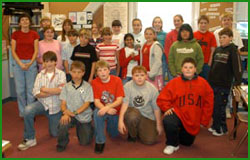
Our class attends White Cliff Elementary in Ketchikan, Alaska, which is the southernmost town in the state. We definitely live in a rain forest! The average rainfall is close to 13 feet a year. In fifth grade we were lucky enough to go out into the forest and attend outdoor school at Orton Ranch on the Naha River. An important lesson we learned from this first-hand experience was that humans need to respect and faithfully care for the forest.

Brooke Hunt is following us from fifth grade to sixth this year as our classroom teacher. She went to outdoor school at Naha as a fifth grader as well—it made a lasting impression! This will be her 38th year in Alaska, but only her eighth year teaching school. She plans to continue living in Alaska and to provide outdoor learning opportunities for kids for many years into the future.
Alexandra Kenny
Director, Grants Programs
National Forest Foundation

Alexandra Kenny has managed the awards programs for the National Forest Foundation (NFF), a non-profit partner to the USDA Forest Service, for four years. She enjoys interacting with NFF’s hundreds of community-based forestry partners nationwide in collaborative efforts to benefit people, water, and wildlife on our extraordinary National Forests and Grasslands. Ms. Kenny has shared her love of learning with children in many capacities and in various disciplines; as a pre-historic archaeologist, a wilderness school counselor, and in managing the visitor experience at the Children’s Museum of Richmond, Virginia. Ms. Kenny loves to learn about the diversity of cultures and ecosystems around the world, and has traveled extensively, throughout North America, Europe, South Africa, Namibia, and Peru.
Alicia M. Landivar
Director, Estancia Montessori

Ms. Landivar is director of Estancia Montessori and works as a Montessori leader with 12 to 17 year old students. In partnership with Joe Vázquez, she has guided the students in their research of the rain forest. The project has been incorporated into the regular environmental research projects carried out in this ecologically focused educational experience.
During the past three years, Ms. Landivar has been implementing an experiental learning approach focused on developing the students’ life skills. Ms. Landivar and Rita Collazo developed a holistic approach curriculum specially targetted to the needs of adolescent students. Based on their research project, this curriculum today guides the education program for middle and high school levels at Estancia Montessori.
The participation of her students in the rain forest project has provided a unique opportunity for them to share their interest and commitment to environmental conservation with other students.
Estancia Montessori
Estancia Montessori is an educational community that serves 12 to 18 year old youth. The school is located in a rural area with ample wet forested lands that are incorporated into the learning experience. The school, located only 25 minutes from El Yunque, has a similar wet, rainy climate.
The research carried out for the rain forest project was done by the Workshop III group that is composed of seven to ninth school levels. This work is part of a series of projects aimed at developing a better ecological place conciousness in students. The students have visited the forest periodically to collect information that they bring to the school to organize and study. The students will be comparing their results from the rain forest to the results of a similar tract at their school. The students are also looking forward to comparing their information with the temperate forests results.
Dr. Ariel Lugo
Director, International Institute of Tropical Forestry
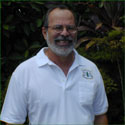
Dr. Ariel Lugo is Director of the International Institute of Tropical Forestry within the United States Department of Agriculture Forest Service, based in Puerto Rico. Dr. Lugo was born in Puerto Rico and obtained his B.S. and M.S. at the University of Puerto Rico. His Ph.D in Ecology is from North Carolina University.
His vast professional experience has included working with the Puerto Rico Department of Natural Resources, Acting Director at the Center for Wetlands in the University of Gainesville, and Staff Member in the Council on Environmental Quality, Executive Office of the President, Head of the Center for Energy and Environment Research, University of Puerto Rico. His USDA Forest Service career started in 1979 as Project Leader of the Institute of Tropical Forestry in Puerto Rico, eventually becoming the Director of the International Institute of Tropical Forestry in 1992 when the Institute changed its name to better reflect its international role.
In addition to leading the Institute, Dr. Lugo is a world renown scientist with vast research experience and has been very active, both locally and internationally, in the defense of critical environmental issues. He has received numerous prestigious awards and distinctions, the most recent, the 2005 Presidential Meritorious Award.
Dr. Rick Meinzer
Research Ecologist, USDA Forest Service
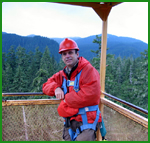
Dr. Rick Meinzer is a Research Team Leader with the USDA Forest Service Pacific Northwest Research Station and is the Forest Service principal scientist for the Wind River Canopy Crane project. The Wind River Canopy Crane is a 250-ft-tall research tower crane that has been operating for about 10 years in an old-growth Douglas-fir/western hemlock forest in southwestern Washington State. The gondola of the crane can be maneuvered to allow scientists to access virtually all parts of the forest, from the ground to the tops of the tallest trees (210 ft) to gain a better understanding of how the forest functions.
Dr. Meinzer has spent about 30 years conducting research on a broad range of topics in plant biology and ecology in a wide range of natural and agricultural ecosystems from the temperate zone to the tropics. After receiving his M.S. at the University of Washington, he served in the U.S. Peace Corps for two years as a visiting professor of biology at the National University of El Salvador where he taught courses in plant physiology and plant anatomy (in Spanish). After returning to the University of Washington to complete his Ph.D., he worked for two years as a professor at the University of the Andes (Universidad de los Andes) in Mérida, Venezuela where he taught classes and conducted research on tropical alpine and tropical savanna plants. He then spent three years in California conducting research on desert plants.
Not inclined to stay in one place for too long, he relocated to an agricultural experiment station in Hawaii where he led research programs on the physiology of tropical crops, native Hawaiian forest trees, tropical forest trees in Panama, and tropical savanna trees in Brazil. After 14 years in Hawaii, in 2000 he moved to his present position with the Forest Service where his research focuses mainly on how water moves through trees, the consequences of tree hydraulic architecture (i.e. the plumbing of trees), how trees cope with stresses such as drought, and what causes trees to grow more slowly as they increase in height. In addition to his research in a temperate, old-growth conifer forest at the Wind River Canopy Crane, he has ongoing research programs in tropical forest sites in Panama where the Smithsonian Tropical Research Institute operates two canopy cranes.
Dr. Meinzer believes that scientific research has been an extremely rewarding career choice. Each day is different and it’s never boring. He gets to choose the research problems he works on and finding out new things about the way plants work is fascinating and satisfying. In addition to being able to do research in beautiful forests in the Pacific Northwest, traveling to exotic places all over the world to conduct research and attend scientific meetings is exciting. He sometimes can’t believe he’s getting paid for doing something that is so much fun!
Dr. Dave Person
Research Wildlife Biologist, Alaska Department of Fish and Game
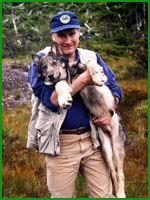
Dr. Dave Person is a research wildlife biologist in Southeast Alaska with the Alaska Department of Fish and Game. He has spent more than 25 years studying or managing large terrestrial animals such as deer, coyotes, foxes, black bears, and wolves. His current research work focuses on predator-prey dynamics between wolves, bears, deer, and humans in the temperate rain forests of southern coastal Alaska. That study examines how forest successional patterns change the capability of habitats to support deer, and how those changes may create long-term ripple effects that influence wolves, black bears, and people.
Susan Soltero
WLII –TV (Univision of Puerto Rico) Meteorologist/Environmental Reporter

Susan Soltero is a meteorologist and environmental reporter with station WLII –TV (Univision of Puerto Rico). She was elected “Reporter of the Year” by the Lion’s Club of Puerto Rico in 2005 and was recognized for her reporting and commitment to the environment by the U.S. Forest Service and the Environmental Quality Board in 2005 and the Puerto Rican Senate in 2004. She was chosen "Woman of the Year" by the Puerto Rican House or Representatives in 2002, elected “Mujer Imágen” by Imágen Magazine, selected Best Environmental Reporter by the Overseas Press Club, and chosen as the Top Ten Most Wanted Businesswoman of the Year by Puerto Rico Business Week Magazine in 2001.
Ms. Soltero has over 20 years of experience as a television and radio reporter and received a Certificate of Global Warming by the University of Puerto Rico and over 100 awards for environmental reporting and community service. She completed a seminar for environmental journalists in 2005 sponsored by the New York Times and is a member of the Society of Environmental Journalists and the National Association of Hispanic Journalists. She just published her second book and is currently working on her third.
Leslie Swada
Education Specialist
Southeast Alaska Discovery Center

Leslie Swada has always been interested in the pursuit of knowledge in various disciplines for she believes all things in this world are connected. After receiving her B.A. from the University of California, she moved to Ketchikan, Alaska in 1989. She worked for the Ketchikan School District until she began working for the Forest Service in 1993. As a forest technician, she completed surveys for wildlife, botany, fisheries, silviculture, timber, engineering, archeology and recreation. Some of her favorite experiences while working in the Tongass National Forest were identifying and documenting migratory songbirds and locating goshawk nests. Leslie believes that her lifetime has been spent in preparation for her current job as education specialist at the Southeast Alaska Discovery Center. She enjoys teaching others what she has learned about the temperate rain forest and all of its wonderful creatures.
Ms. Swada lived in Europe for five years and traveled extensively throughout the region. This experience sparked her interest in seeking out the unknown. To this day she enjoys traveling each year to learn about the different ecosystems and cultures throughout the world. Some of her favorite destinations have been Egypt, Indonesia, Turkey, Greece, Morocco, Italy, England, Scotland, and Australia. This year she plans on watching the Green Bay Packers play the Chicago Bears at Lambeau Field and fulfilling a lifelong dream of visiting India. When she is home in Ketchikan, she also works as a choreographer and instructor of eastern dance forms.
|















